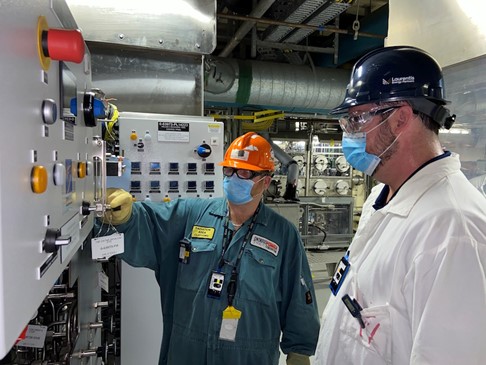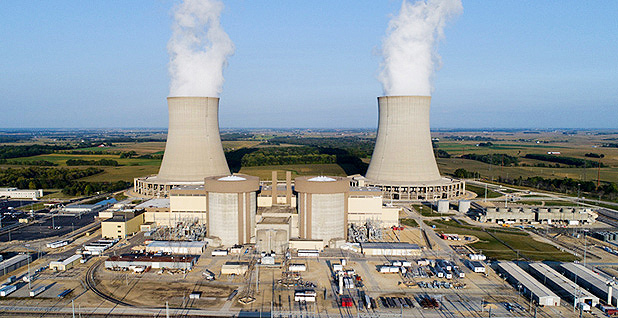September 20, 2021, 12:04PMNuclear Newsthe Standards Committee An artist’s rendering of the NuScale plant. (Image: NuScale)
For more than two decades, the American Nuclear Society’s Standards Committee has recognized the benefit of incorporating risk-informed and performance-based (RIPB) methodology into ANS standards to improve their effectiveness, efficiency, and transparency. In general, standards using RIPB methods with properly identified and structured objectives need less modification and can be expected to remain valid for much longer periods.
BWXT Canada’s Cambridge, Ontario, facility. (Photo: BWXT Canada)
NuScale Power announced earlier this week that manufacturing process development work on its small modular reactor—the NuScale Power Module—is advancing at BWXT Canada Ltd.’s Cambridge, Ontario, facility in preparation for module fabrication. NuScale said that this work is critical to the development of its SMR technology and is an example of the supply chain development opportunities for Canadian companies with the requisite power plant equipment expertise.
Rendition of the IMSR400 power plant in the configuration proposed for the Darlington site. (Image: Terrestrial Energy)
Terrestrial Energy has upgraded the design of its Integral Molten Salt Reactor (IMSR) nuclear power plant, the company announced on September 14. The proposed facility will now feature 390 MWe of generation capacity for grid supply from twin reactors and generators.
Illinois governor J.B. Pritzker appreciates applause at the signing event for the state's new energy bill.
In an hour-long ceremony held yesterday at Chicago’s Shedd Aquarium amid some fanfare (it included an appearance by lizards, a snake, and a penguin), Illinois Gov. J.B. Pritzker signed into law the Climate and Equitable Jobs Act (S.B. 2408). The bill is a sweeping overhaul of the state’s energy policies aimed at phasing out fossil-fuel power generation and placing Illinois on a path to become a 100 percent carbon-free energy producer by 2050.
Don Perrie (left), of OPG, and Michael Lefebvre, of Laurentis Energy Partners, examine the He-3 extraction tool installed at Darlington NPP
Laurentis Energy Partners, a subsidiary of Ontario Power Generation (OPG), has launched a new program to produce helium-3. The He-3 will be obtained from tritium stored at OPG’s Darlington nuclear power plant, a four-unit CANDU station located about 100 kilometers east of Toronto.
Darlington houses one of the world’s largest reserves of tritium, which is a by-product of the heavy water used in CANDU reactors.
U.S. energy secretary Jennifer Granholm and India’s minister of petroleum and natural gas Hardeep Singh Puri remotely meet (with others in the background) during the virtual launch of a "newly revitalized” U.S.-India clean energy partnership.
U.S. energy secretary Jennifer Granholm and India’s minister of petroleum and natural gas, Hardeep Singh Puri, last week presided over the virtual launch of what the Department of Energy termed the “newly revitalized” U.S.-India Strategic Clean Energy Partnership (SCEP).
Governor J. B. Pritzker says he will sign the landmark legislation
The Byron (left) and Dresden generating stations.
The yearlong, nail-biting drama over the fate of Exelon’s Byron and Dresden nuclear plants came to an end on Monday afternoon when the Illinois Senate gave its nod to S.B. 2408, a wide-ranging clean energy package that seeks to phase out fossil-fuel power generation in the state and place it on a path to 100 percent carbon-free energy by 2050.
This large-bore, full-scale high-temperature superconducting magnet designed and built by Commonwealth Fusion Systems and MIT’s Plasma Science and Fusion Center is the strongest fusion magnet in the world. (Photo: Gretchen Ertl, CFS/MIT-PSFC)
A high-temperature superconducting magnet reached and maintained a magnetic field of more than 20 tesla in steady state for about five hours on September 5 at MIT’s Plasma Science and Fusion Center. Not only is the magnet the strongest high-temperature superconducting (HTS) magnet in the world by far, it is also large enough—when assembled in a ring of 17 identical magnets and surrounding structures—to contain a plasma that MIT and Commonwealth Fusion Systems (CFS) hope will produce net energy in a compact tokamak device called SPARC in 2025, on track for commercial fusion energy in the early 2030s.
The Byron nuclear power plant
(This story has been updated from yesterday's post about the Illinois energy package.)
With only days remaining before the scheduled retirement of Exelon Generation’s Byron nuclear plant, the Illinois House has approved a comprehensive energy package (S.B. 2408) that would save the plant, as well as the state’s similarly struggling Braidwood and Dresden facilities.
Energy secretary Jennifer Granholm (seated at left) and Ukrainian energy minister Herman Galushchenko (seated at right) on August 31 sign an agreement to bolster U.S.-Ukrainian energy cooperation. Ukraine’s president, Volodymyr Zelensky, stands in the background. (Photo: DOE)
U.S. energy secretary Jennifer Granholm and Ukrainian energy minister Herman Galushchenko last week signed a joint statement of intent to advance energy and climate cooperation through the U.S.-Ukraine Strategic Energy and Climate Dialogue. The signing took place during a visit to Washington, D.C., by Ukrainian president Volodymyr Zelensky for meetings with President Biden at the White House.
During a recent road closure on the Hanford Site, Florida International University students (from left) Jeff Natividad, Joel Adams, and Thi Tran test a radiation mapping robot outside a tank farm. The students are part of a unique internship program between the DOE’s Office of Environmental Management and the university. (Photo: DOE OEM)
As part of a fellowship program between the Department of Energy’s Office of Environmental Management and Florida International University, a group of FIU students participated in a summer internship initiative called the Science and Technology Workforce Development Program. The program is run in conjunction with Washington River Protection Solutions (WRPS), the Hanford Site’s tank operations contractor in Washington state.
During the week-long mission, the IAEA team is carrying out practical NDT training with specialized equipment. (Photo: Abel Domato/BAC)
In the aftermath of a devastating explosion in the port of Beirut, Lebanon, in August 2020, an International Atomic Energy Agency team visited the country at the government’s request and found no evidence of artificial radionuclides and no increase in radiation levels. The powerful blast, which was caused by an explosion of improperly stored ammonium nitrate, killed more than 200 people and leveled numerous buildings while leaving other buildings standing with possible structural damage. The IAEA recently announced that a different team of experts has traveled to Lebanon with a new mission: to assist the nation in the use of non-destructive testing (NDT) to check the structural soundness of buildings that were impacted by the explosion.







. of OPG, and Michael Lefebvre, of Laurentis Energy Partners, examine tew He-3 extraction tool installed at Darlington NPP.jpg)









 Nuclear power plants around the world generated 2,553 TWh of electricity in 2020, a drop of 104 TWh from 2019’s total, according to
Nuclear power plants around the world generated 2,553 TWh of electricity in 2020, a drop of 104 TWh from 2019’s total, according to 